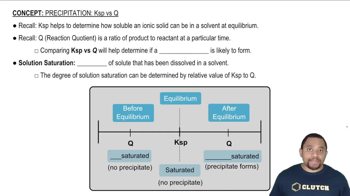Here are the essential concepts you must grasp in order to answer the question correctly.
Enthalpy (q)
Enthalpy, represented as 'q', refers to the heat content of a system at constant pressure. In the context of the airbag deployment, the rapid chemical reaction generates heat, indicating that the system is releasing energy to the surroundings. Therefore, for the reactants, the sign of q is expected to be negative, as the system loses heat during the exothermic reaction.
Recommended video:
Ksp vs Q in Precipitation
Work (w)
Work, denoted as 'w', is the energy transferred when a force is applied over a distance. In the case of an airbag, the rapid expansion of gas against the atmospheric pressure represents work done by the system. Since the system is expanding, the work done by the system is considered positive, leading to a positive sign for w.
Recommended video:
Work Function Calculation Example
First Law of Thermodynamics
The First Law of Thermodynamics states that energy cannot be created or destroyed, only transformed from one form to another. In the airbag scenario, the chemical energy from the reactants is converted into thermal energy (heat) and mechanical energy (work) as the gas expands. This principle helps in understanding the relationship between q, w, and the internal energy change of the system.
Recommended video:
First Law of Thermodynamics




